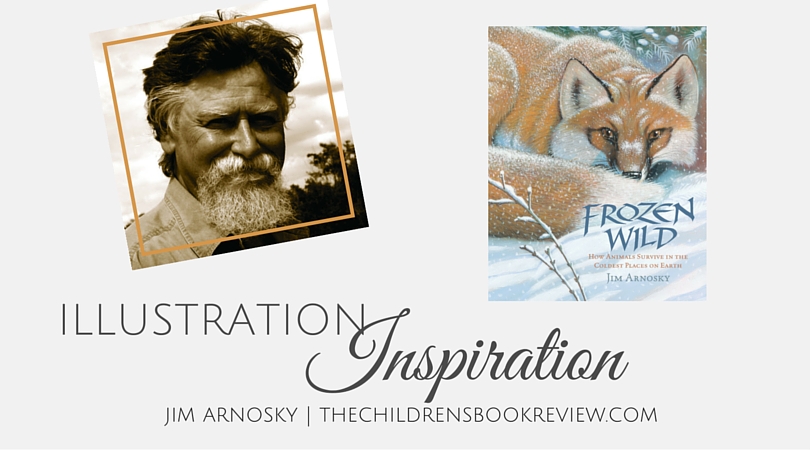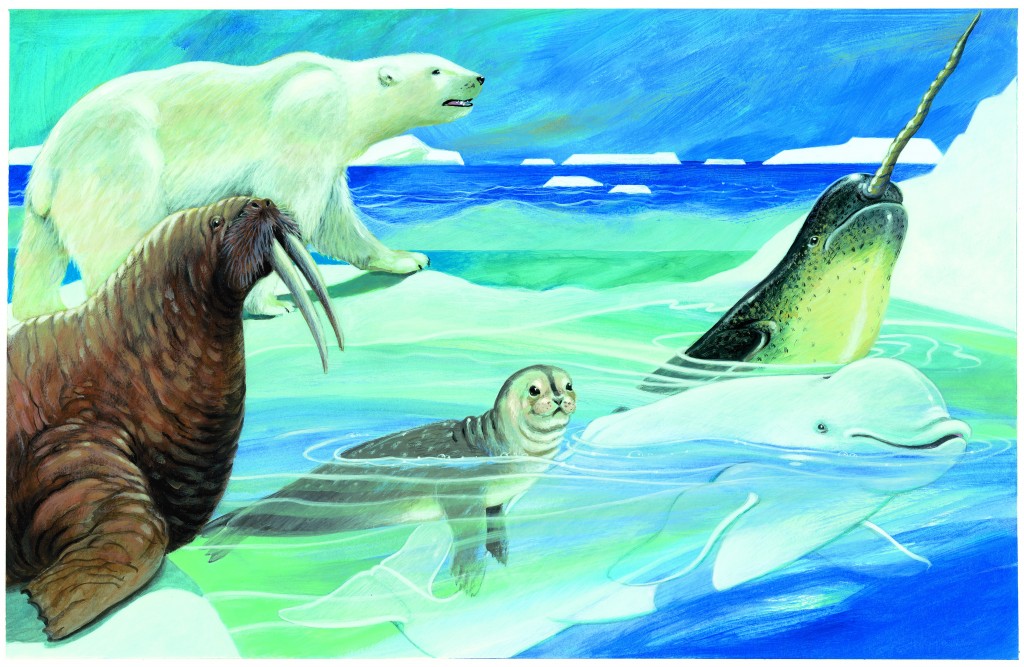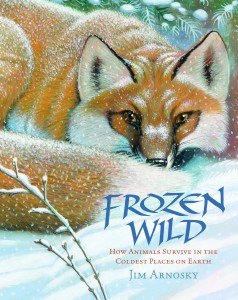The Children’s Book Review | September 29, 2015

Artist and naturalist Jim Arnosky has been honored for his overall contribution to literature for children by the Eva L. Gordon Award and the Washington Post/Children’s Book Guild Award for nonfiction. Many of his books have been chosen as ALA Notable Books, including Wild Tracks! A Guide to Nature’s Footprints and Thunder Birds: Nature’s Flying Predators, which was also included on the Bluebonnet Master List for the state of Texas. The other books in Jim’s nature series are Slither and Crawl: Eye to Eye with Reptiles, Creep and Flutter: The Secret World of Insects and Spiders, Shimmer & Splash: The Sparkling World of Sea Life, and Tooth & Claw: The Wild World of Big Predators. Jim lives in South Ryegate, VT.
Latest published book …
My latest published work is Frozen Wild: How Animals Survive In the Coldest Places on Earth published by Sterling. It was inspired by years of tracking our wildlife neighbors in the snow and cold and wondering how they got through the night after I had gone home to my warm house.
Inspired by …
Most of my books are initially inspired by the journal entries I make after each outing. The polar animal portions of the book were planned and designed after much research in books. We do get get it cold here in Northern Vermont (sometimes minus 40 degrees) but nothing like the cold at the poles. So I had to use all the information I could find to get the facts right. I describe how I worked on these sections of the book in an author’s note at the end, encouraging children to visit zoos where polar animals are kept and cared for and to keep an eye out for polar species of birds that migrate to the temperate zones each year.
Art medium used …
The art medium I use is mixed. Pencil. Acrylic paint. White Chalk. The chalk is used for drawing on color and then painted into the next layer of color. I never use an eraser on my actual art, except to clean my own hand smudges from the paper.

Artistic process …
My artistic process begins always with an underpainting of single tone or mixed colors that best represent the environment I will be depicting. These underpaintings are almost abstractly applied. Then I draw on that color base painting in white chalk and paint the drawing with layer after layer of color. This layering is what gives my pictures such a richness of color and also a depth of paint where you can see much of the initial base painting coming through. It’s kind of like looking into a forest and seeing through the rows of trees to a spot deep inside the scene.
Favorite place to create & illustrate …
My favorite places to work are, in the case of sketches, outdoors in my canoe or on my boat Crayfish. Much of my writing is done in my head while walking in wild places. My finished art is done either in my drawing room here at our Vermont farm where I am able to leave the board and walk in the hills or fields or up in the mountains on the trails I maintain. Or my art finishes are done in the Florida Keys where we are situated in Islamorada equi-distant from the Everglades to our north and the coral reef to our south. Both places provide much inspiration for future books even as I am working on the book at hand.
Most used art supply or tool …
My most used art tools are pencil or pen and ink. These are the two tools I use in my preliminary sketches and in my journal entries. Then I have to say camera. For me the video camera is a tool to study again and again the movements of animals. And to capture images of them in their natural habitats.
Illustrator idols …
My illustrator idols are Winslow Homer, Bruno Liljefors, Bob Kuhn, Roger Tory Peterson, Charles Tunnicliffe and Audubon. Some of these I know are not considered illustrators but they are my favorite artists over all.
All-time favorite children’s book you didn’t illustrate …
It’s hard for me to think of a favorite children’s book since I was not really familiar with children’s books while growing up. In fact, it was Trina Schart Hyman, the art director for Cricket magazine who wrote to me once scolding, “Jim, go out and look at a children’s book in a bookstore once in awhile!” She wanted me to know who my contemporaries were and what field she felt I was excelling in. I had no art training outside of my father’s technical drafting. Not art school. No college. And she sent me out in the world to discover children’s books and book illustrations as an art form. I love Trina’s “Snow White” and Hemingway’s “The Old Man and the Sea” with Tunnicliff’s beautiful scratch board drawings. But to this day, my all time favorite book is not a children’s book It is KON-TIKI by Thor Heyerdahl.
A literary character to create art with …
I created the literary character “Crinkleroot” over 40 years ago, just about the time Jimmy Buffet created his album A1A. He was in Key West. I was living in a one room cabin in the mountains of Pennsylvania. Deanna and I and our daughters lived there 4 ½ years while I slowly studied nature and began my freelance career. It was a very rugged life. In the cabin, I wrote Crinkleroot’s (and my) first book, “I Was Born In A Tree And Raised By Bees”. It was to become the foundation of my life’s work. Just as A1A formed the foundations on which Buffett’s life work is laid. I mention Buffett because all my writer heroes at first were song writers. We didn’t have books in our home. I only started reading books when I was in the Navy, when I read a biography of Winslow Homer. Then I read “The Art Spirit” by Robert Henri.
Currently working on …
I am currently working on paintings featuring Deanna’s gardens, and I’m also preparing for a new Crinkleroot project. Most recently I have completed a book on invasive species in our wilds. Its called “Wild Invaders” and will be published by Starwalk Kids Media. I’ve been researching this subject in the Everglades and else where for over ten years.
Connect with Jim Arnosky …
www.jimarnosky.com | www.crinkleroot.com
Most social media do not provide enough depth of individual expression for me to say all I wish to convey. I answer all my mail very thoughtfully by letter.
 Frozen Wild: How Animals Survive In the Coldest Places on Earth
Frozen Wild: How Animals Survive In the Coldest Places on Earth
By Jim Arnosky
Publisher’s Synopsis: Quietly it comes—the dark and chill of winter. And in the snow-covered fields and forests, the great northern plains, vast stretches of frozen tundra, and icy polar regions, wild animals have to survive day after day, night after night, out in the cold. How do they do it? Kids can bundle up and join award-winning author, illustrator, and naturalist Jim Arnosky as he follows the tracks of otters, beavers, moose, polar bears, killer whales, penguins, fur seals, and other creatures to discover more about their lives during this frigid season. Arnosky’s stunning art includes five magnificent foldouts that reveal worlds under the ice and at the farthest, frostiest reaches of the globe.
Ages 6-10 | Publisher: Sterling Children’s Books | 2015 | ISBN-13: 978-1454910251
Available Here:
Discover more picture book illustration inspiration and books like “Frozen Wild,” by Jim Arnosky, on The Children’s Book Review by following along with our Illustration Inspiration series and articles tagged with Jim Arnosky, Natural History Books, Nature, Nature Studies, Polar Animals, Environment & Ecology, and Picture Books.
